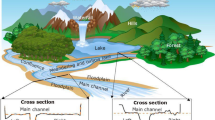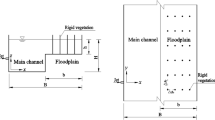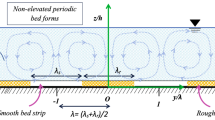Abstract
In a trapezoidal compound channel, the side slope of the main channel has a significant effect on the flow structure and the momentum exchange in the connecting region of the main channel and the floodplain. The three-dimensional compound channel flows with the 90°, 60°, 45° and 30° side slopes of main channel were simulated by solving the Navier–Stokes equations with the Reynolds Stress Model (RSM). The effects of main channel side slopes on the secondary currents, streamwise velocities, bed shear stresses, Reynolds shear stresses, turbulent intensities and the turbulence anisotropy were analyzed. The results show that (1) the secondary currents are modified as a result of the variation of the turbulence anisotropy \((\overline {{w^{\prime 2}}} - \overline {{v^{\prime 2}}} )\), which is caused by the varied momentum exchange between the main channel and the floodplain; (2) as the main channel side slope decreases, the intensity of the secondary currents and their direct influence on the streamwise velocity, the bed shear stress, the Reynolds shear stress and the turbulent intensity becomes weaker. The deceleration of the streamwise velocity in the connecting region becomes less remarkable. The bed shear stresses tend to follow a more uniform distribution and are found to have one drop at the bottom of the main channel sidewall and the other drop at the edge of the floodplain when the side slope of the main channel is not vertical. These are different from the case of the vertical main channel side wall, in which only one minimum and one maximum values are observed at the interface region. The total magnitude of the turbulence intensity near the junction edge increases by a much smaller extent. The discharge ratio of the main channel increases while that of the floodplain decreases. The magnitude difference of \(- \overline {{{{u}}^\prime }{w^\prime }}\) between the main channel and the floodplain in the interface region decreases, which implies the momentum transport becomes weaker due to the diminished secondary currents. These results will contribute for designing the most optimum cross-section shape for flood discharge of the compound channel.














Similar content being viewed by others
References
Tominaga A, Nezu I (1991) Turbulent structure in compound open-channel flows. J Hydraul Eng 117(1):21–41
Sayed-Abdul-Hamid S, Sayed-Hamed S, Hamed S (2016) Accuracy of numerical simulation in asymmetric compound channels. Int J Civ Eng. doi:10.1007/s40999-016-0113-3.
Ardeshir A (2004) Mathematical model of river bed variation prediction at Alluvial rivers under gradually varied flow condition. Int J Civ Eng 2(1):8–22
Rezaei B, Knight DW (2009) Application of the shiono and knight method in compound channels with non-prismatic floodplains. J Hydraul Res 47(6):716–726
Ackers P (1993) Flow formulae for straight two-stage channels. J Hydraul Res 31(4):509–531
Babaeyan-Koopaei K, Ervine DA, Carling PA, Cao Z (2002) Velocity and turbulence measurements for two overbank flow events in River Severn. J Hydraul Eng ASCE 128(10):891–900
Ackers P (1993) Stage-discharge functions for two-stage channels: the impact of new research. J Water Environ Manag 77(1):52–60
Knight DW, Sellin RHJ (1987) The SERC flood channel facility. J Inst Water Environ Manag 1(2):198–204
Güllü H (2012) Prediction of peak ground acceleration by genetic expression programming and regression: a comparison using likelihood-based measure. Eng Geol 141–142:92–113.
Güllü H, Erçelebi A (2007) Neural network approach for attenuation relationships: an application using strong ground motion data from Turkey. Eng Geol 3–4(93):65–81.
Yang KJ (2006) Flow resistance and sediment transport in compound channels (Doctoral dissertation). Sichuan University, Chengdu.
Yang ZH, Gao W, Huai WX (2010) Study on the secondary flow coefficient of over bank flow. Appl Math Mech 6:681–689
Yang ZH, Gao W, Huai WX (2010) Secondary flow coefficient of over bank flow. Appl Math Mech 31:709–718. doi:10.1007/s10483-010-1305-9.
Yang KJ, Liu XN, Cao SY (2014) Stage-Discharge prediction in compound channels. J Hydraul Eng 140(4):1–8
Bottacin-Busolin A, Marion A (2010) Combined role of advective pumping and mechanical dispersion on time scales of bed form-induced hyporheic exchange. Water Resour Res 46(8):W08518. doi:10.1029/2009WR008892
Kang H, Choi S-U (2005) 3D numerical simulation of compound open-channel flow with vegetated floodplains by Reynolds Stress Model. KSCE J Civ Eng 9(1):7–11
Jing H, Guo Y, Li C, Zhang J (2009) “Three-dimensional numerical simulation of compound meandering open channel flow by the Reynolds stress model. Int J Num Methods Fluids 59(8):927–943. DOI:10.1002/fld.1855
Daly BJ, Harlow FH (1970) Transport equations in turbulence. Phys Fluids 13:2634–2649
Cardenas MB, Wilson JL (2007) Effects of current–bed form induced fluid flow on the thermal regime of sediments. Water Resour Res. doi:10.1029/2006WR005343
Rameshwaran P, Naden PS (2003) Three-dimensional numerical simulation of comound channel flows. J Hydraul Eng-ASCE 129:645–652
Salehin M (2004) “Hydrodynamics of hyporheic exchange for complex natural streambed topography”, channel geometry and sediment structure, Ph.D. thesis; Northwestern University, USA.
FLUENT. FLUENT 6.3 Documentation (2006). Retrieved from http://my.fit.edu/itresources/manuals/fluent6.3/help/index.htm. Last Accessed 28 Oct 2010. Fluent Inc., Lebanon,
Launder BE, Spalding DB (1974) The numerical computation of turbulent flows. Comput Methods Appl Mech Eng 3:269–289
Tominaga A, Nezu I, Ezaki K (1989) Three-dimensional turbulent structure in straight open channel flows. J Hydraul Res 27(1):149–173
Acknowledgements
This study was supported by the National Natural Science Foundation of China under Grant number 41323001; the Priority Academic Program Development of Jiangsu Higher Education Institutions under Grant number SYS1401; and the National Key Research and Development Program of China under Grant number 2016YFC0402605.
Author information
Authors and Affiliations
Corresponding author
Rights and permissions
About this article
Cite this article
Xiao, Y., Wang, N., Liang, D. et al. Flow Structures in Trapezoidal Compound Channels with Different Side Slopes of Main Channel. Int J Civ Eng 16, 823–835 (2018). https://doi.org/10.1007/s40999-017-0212-9
Received:
Revised:
Accepted:
Published:
Issue Date:
DOI: https://doi.org/10.1007/s40999-017-0212-9




